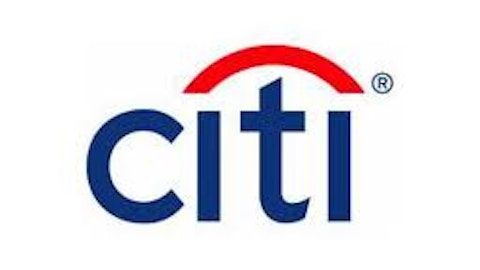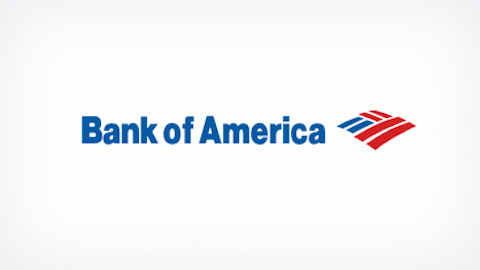JPMorgan Chase & Co. (NYSE:JPM) complains of “lower deposit margins.” Citigroup Inc. (NYSE:C) calls it “spread compression.” I like that term better–you can practically feel the bank getting squished between encroaching interest rates.
It has a lot to do with net interest margin. Banks live by net interest margin. When you take your hard-earned paycheck and deposit it into your local bank, that money doesn’t sit around. The bank uses your money as loan material to generate interest revenue. In return for the use of your money, you get paid a small interest rate on your deposit. The difference between the deposit interest rate and the loan interest rate is net interest margin. That’s how a bank makes money.
Here’s a fun graph. These are the quarterly net interest margins of U.S. banks since 1984.

Now picture a bank like JPMorgan Chase & Co. (NYSE:JPM) or Citigroup Inc. (NYSE:C) trying to make a profit in the space between the blue line and the bottom of the graph. (I know, the bottom of the graph is 3.0%, not 0%, but just play along.) Follow the line to 2013. See how tight that space is? That’s spread compression.
You know what’s even more astonishing? In almost 30 years, the only other time that net interest margin was this low was in the fourth quarter of 2008 when the market crashed. No, I’m not making any wild-eyed predictions about imminent doom. I’m just saying that banks aren’t exactly feeling the economic recovery.
Profits running off
JPMorgan Chase & Co. (NYSE:JPM)’s consumer and community banking segment experienced a 6% drop in revenue this past quarter. Not surprisingly, net interest income for the segment was down because of “lower deposit margins and lower loan balances due to portfolio runoff.” Portfolio runoff occurs in a mortgage-backed securities (MBS) portfolio when loans prepay.
That sounds confusing, so here’s an example. When interest rates fall or home values rise, homeowners want to refinance their homes to either lock in a better rate, or to “monetize” the new equity in their homes. Refinancing pays off the previous loan in full, meaning that the mortgage portfolio is stripped of interest income. So, not only is JPMorgan Chase & Co. (NYSE:JPM) squeezed by falling interest rates, it is also bleeding out portfolio value of mortgage-backed securities as customers rush to refinance their homes.
These troubles will continue for JPMorgan as long as the Fed keeps rates unnaturally low. When the Fed cuts back on buying so many bonds, that could be the right time to buy into JPMorgan Chase & Co. (NYSE:JPM), because interest rates will start to rise again.
Loans running away
“Spread compression globally and consumer de-leveraging in North America” flattened revenue growth for Citigroup Inc. (NYSE:C)’s global consumer banking segment in Q1 2013. We already talked about spread compression, but what is “consumer de-leveraging”? It’s actually just households deciding to pay off debt. Consumer de-leveraging hurts banks because banks will have fewer income streams from outstanding loans.
As an aside, the Federal Reserve Bank of Boston published a brief on consumer de-leveraging in October 2012. The brief argues statistically that consumer de-leveraging hasn’t had a significant impact on consumer spending. In other words, people are paying off debt, but they aren’t cutting back on spending in order to do so. This might explain why some companies seem to be recovering just fine while banks lag behind. Consumers are spending in other industries, but what banks get are fewer loan revenues.
Again, unless the Fed allows interest rates to rise, Citi’s consumer-banking operations will languish.
Banks are getting desperate
Depository institutions aren’t the only ones feeling the pinch. A WSJ article recounts the fixed-income woes of investment bank Morgan Stanley (NYSE:MS). In 2012, fixed-income and commodities trading made up 22% of net revenue. Company leaders decided this year to lower revenue goals for Morgan Stanley’s fixed-income unit in order to focus on profitability. It’s about time. Last quarter’s ROE (return on equity) is sitting in the single-digits. And last year, Morgan Stanley watched 1.1% of the fixed-income market slip into competitors’ territory.
Another example is Bank of America Corp (NYSE:BAC). B of A, owner of Merrill Lynch, is stretching relationships in order to boost banking revenue. Q1 2013 saw consumer and business banking net income decrease 4% from the year-ago quarter. Since January, Bank of America has been pushing Merrill Lynch representatives to refer investment clients to Bank of America. Though the actual dollar results are still pending, it is widely believed that the cross-selling strategy hasn’t improved the already-strained relationship between the two firms. Too bad.
As mortgage rates slip and customers refinance, mortgage servicing and other paperwork gets expensive. Wells Fargo & Co (NYSE:WFC)’s solution is to outsource jobs to India. In June 2012, the company employed 3,000 people in India, with plans to send more jobs over there. WSJ reports that “This year, Indian outsourcing firms will bring in $316 million in mortgage work….” There is some concern that proper due diligence will be neglected, but interest rates aren’t very forgiving. Wells Fargo’s priority right now is cutting costs.
Conclusion
There you have it. Consumers are joyfully taking advantage of rock-bottom interest rates by paying off debt and refinancing their homes. The result is rough on banks. Interest rate spreads are squeezing banks so tightly that they have to perform all sorts of financial gymnastics in order to stay competitive. Banks led the way into the recession, and it looks like the other industries will have to yank banks out of it.
This article was written by Nathan Adamo and edited by Chris Marasco. Chris Marasco is Head Editor of ADifferentAngle. Neither has a position in any stocks mentioned.
The Motley Fool recommends Bank of America and Wells Fargo. The Motley Fool owns shares of Bank of America, Citigroup Inc (NYSE:C) , JPMorgan Chase & Co (NYSE:JPM)., and Wells Fargo.
The article Interest Rates Are Squeezing the Life Out of These Banks originally appeared on Fool.com.
Copyright © 1995 – 2013 The Motley Fool, LLC. All rights reserved. The Motley Fool has a disclosure policy.





